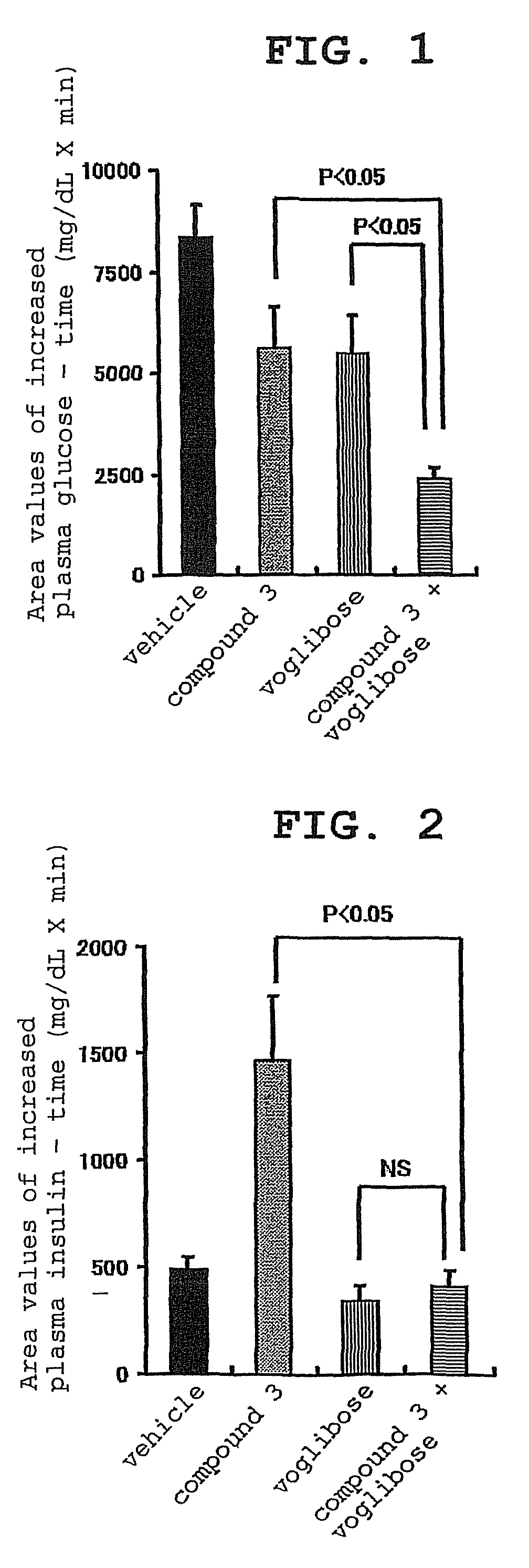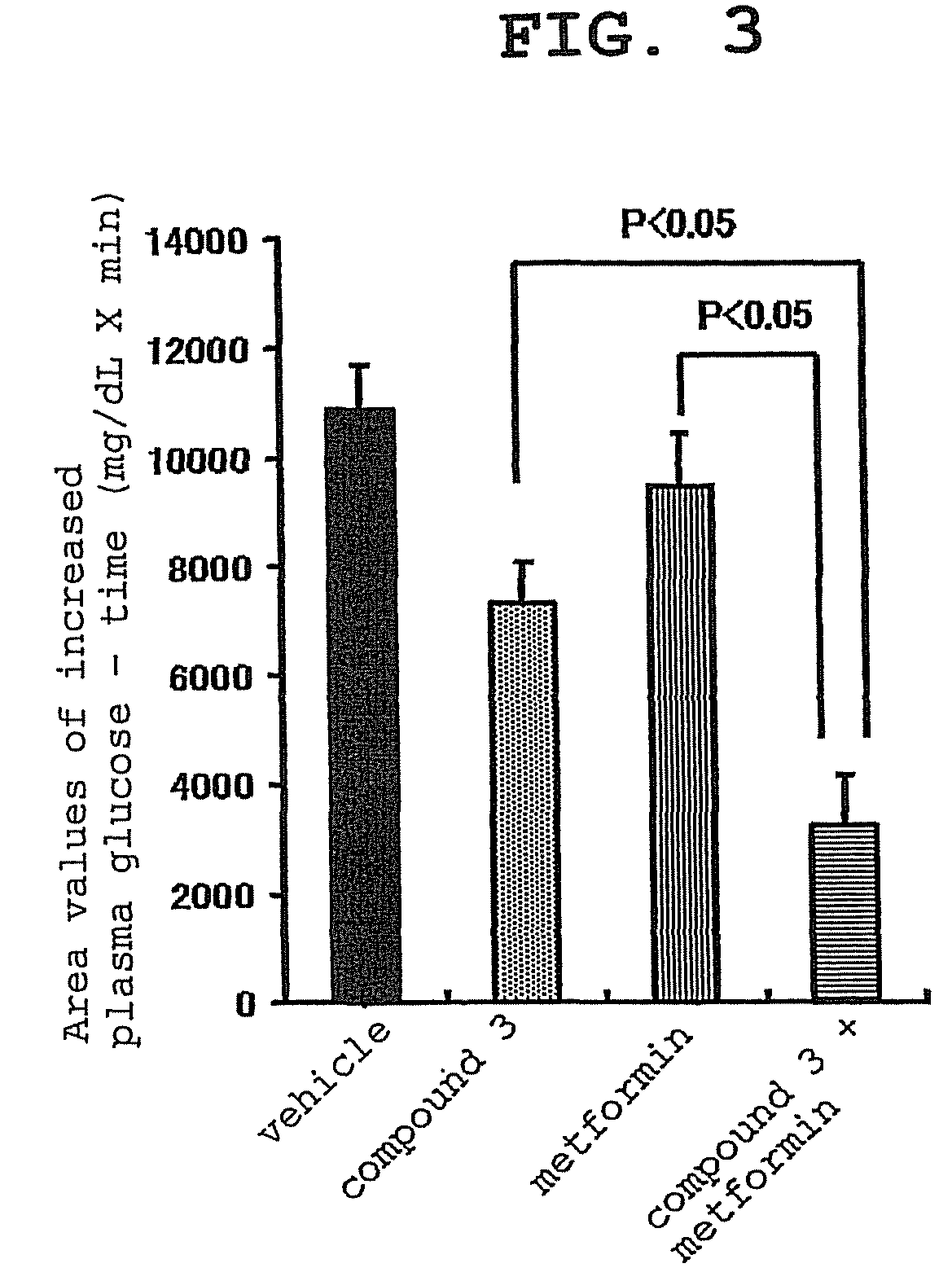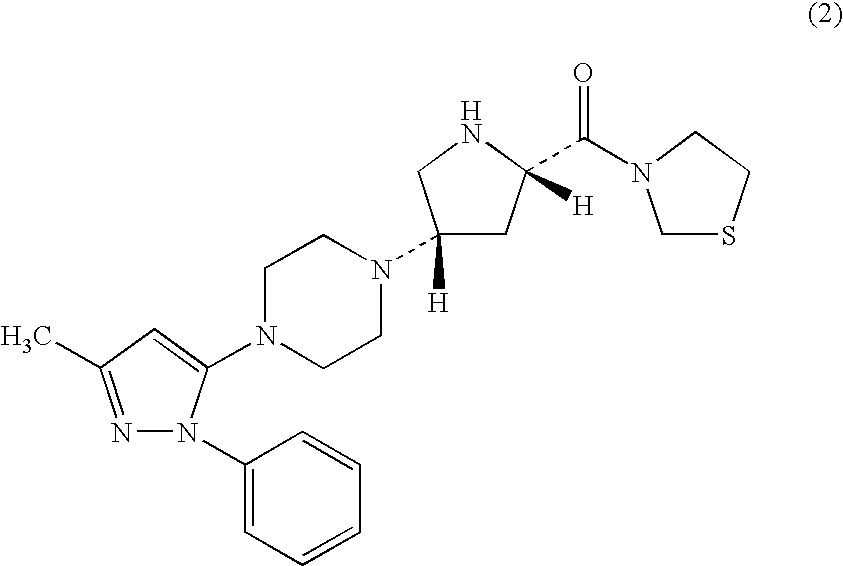Concomitant pharmaceutical agents and use thereof
a technology -cells, which is applied in the field of concomitant pharmaceutical agents, can solve the problems of affecting the treatment progress or treatment, the risk of hypoglycemia of su agents, and the inability of single pharmaceutical agents to sufficiently improve the complicated pathology of diabetes, etc., and achieves the effects of preventing the progression of diabetes
- Summary
- Abstract
- Description
- Claims
- Application Information
AI Technical Summary
Benefits of technology
Problems solved by technology
Method used
Image
Examples
experimental example 1
Effect of Compound 3, Voglibose (α-glucosidase Inhibitor) and Combination Thereof on Plasma Glucose Level and Insulin Concentration in Oral Carbohydrate Loading Test of Zucker Fatty (Hereinafter to be Indicated as ZF) Rats
(Test Method)
[0157]For this test, overnight fasted male ZF rats were used. Four groups each containing 5 rats were formed. Administration substances shown in the following Table were administered to the animals of each group. That is, 0.5% hydroxypropylmethylcellulose solution, which was the vehicle used for the preparation of compound 3 and voglibose, was given to group 1, compound 3 (0.1 mg / kg) was given to group 2, voglibose (0.1 mg / kg) was given to group 3, and a combination of compound 3 (0.1 mg / kg) and voglibose (0.1 mg / kg) was given to group 4. The dose was 2 mL / kg in all cases. After 15 min, a mixed carbohydrates solution of starch, sucrose and lactose (mixing rate 6:3:1) was orally administered at 3.5 g / kg. The dose of the carbohydrates solution was 10 mL / ...
experimental example 2
Effect of Combination of Compound 3 and Metformin in Oral Carbohydrate Loading Test of ZF Rats
(Test Method)
[0160]For this test, overnight fasted male ZF rats were used. Four groups each containing 8 rats were formed. Administration substances shown in the following Table were administered to the animals of each group. That is, 0.5% hydroxypropylmethylcellulose solution, which was the vehicle used for the preparation of compound 3 and voglibose, was given to group 1, compound 3 (0.3 mg / kg) was given to group 2, metformin (50 mg / kg) was given to group 3, and a combination of compound 3 (0.3 mg / kg) and metformin (50 mg / kg) was given to group 4. The dose was 2 mL / kg in all cases. After 15 min, a mixed carbohydrates solution of starch, sucrose and lactose (mixing rate 6:3:1) was orally administered at 3.5 g / kg. The dose of the carbohydrates solution was 10 mL / kg. Blood samples were collected over time, and plasma glucose concentration was measured. The measurement results are shown in FI...
PUM
| Property | Measurement | Unit |
|---|---|---|
| time | aaaaa | aaaaa |
| time | aaaaa | aaaaa |
| body weight | aaaaa | aaaaa |
Abstract
Description
Claims
Application Information
 Login to View More
Login to View More - R&D
- Intellectual Property
- Life Sciences
- Materials
- Tech Scout
- Unparalleled Data Quality
- Higher Quality Content
- 60% Fewer Hallucinations
Browse by: Latest US Patents, China's latest patents, Technical Efficacy Thesaurus, Application Domain, Technology Topic, Popular Technical Reports.
© 2025 PatSnap. All rights reserved.Legal|Privacy policy|Modern Slavery Act Transparency Statement|Sitemap|About US| Contact US: help@patsnap.com



